- Policy Proposal
- Industry, Business, Technology
Issues and Prospects for CSR in Japan: Analysis of Japan’s CSR Corporate Survey
January 30, 2015
1. Implementation of the CSR Corporate Survey
(1) Introduction
Social issues are becoming increasingly complex and segmented, and there are growing limits to what the government can do to address them. There are rising expectations, therefore, of greater contributions from the private sector through corporate social responsibility activities. Needless to say, corporations are profit-making organizations, so they will be unable to deal with social issues using the same approaches as the government, whose prime objective is to promote public welfare. In particular, corporate activities are subject to cost performance constraints more stringent than those of public enterprises. This is bound to have an effect on the shape of social issue resolution through CSR activities. To promote issue resolution based on corporate activities, we must consider what forms of CSR are desirable for both society and businesses. And for this it is important to ascertain the actual state of Japan’s CSR activities from the perspective of social issue resolution.
There are many sources of information on CSR in Japan. Individual corporations publish CSR and sustainability reports, and comparative information is available through the comprehensive surveys conducted by specialized media organizations like Toyo Keizai and the Nikkei. [1] As for how CSR reports are viewed from the side of the citizens, the NTT Group conducts an ongoing questionnaire survey directed at readers of environmental and social reports. [2] There are also surveys of socially responsible investment as seen from the perspective of investors. [3] But there is no overview of CSR activities in Japan that focuses on their role in the resolution of social issues. Nor has there been much published that analyze or scrutinize CSR from a broader vantage point, encompassing such concerns as the correlation of CSR activities with business operations and corporate strategies and the process of creating corporate value.
So when the Tokyo Foundation launched its CSR research project in 2013, the first task it undertook was to conduct a questionnaire survey focusing on the relationship between CSR and the major issues confronting Japanese and international society. The survey was sent to about 2,000 companies within Japan, including listed corporations, major unlisted companies, and major foreign affiliates. Among the questions, companies were asked about the characteristics of the CSR activities they deemed successful, the targets of their activities (which social issues they were focusing on), the relevance of these activities to their business operations, whether or not they were working with nongovernmental organizations or others in the civil sector, and what issues they faced in promoting CSR.
(2) Basic Perspective
The basic perspective adopted for the survey is as follows.
First, the Japanese term used in the survey for “social issue” was shakai kadai (社会課題), which can also be translated as “social problem” or “social challenge.” The sorts of issues that shakai kadai brings to mind range from global concerns, such as the environment, poverty, and gender-based discrimination, to domestic, local matters, including the increasing number of depopulated villages with elderly residents and regional disparities in healthcare services. The term thus has diverse meanings, and its scope changes with the passage of time. This makes it hard to define.
A look through published materials concerning “social issues” reveals some common perceptions, such as that their resolution is believed to contribute to society’s sustained development or other public interests and that not enough is being done to address them. The definition we adopted in our questionnaire was thus made broad enough to cover as many concepts as possible, drawing from these shared points: “Problems whose resolution is necessary for the sake of society’s sustained development but for which resources (people, goods, money, technology, knowledge, etc.) are not being sufficiently invested.”
(3) Classification of Social Issues and Outline of the Survey
Next, a framework was developed to classify various social issues based on this definition. For this we took note of existing strategies for issues requiring resolution to achieve sustained development, such as the Millennium Development Goals adopted by the United Nations and the United Nations Global Compact. We then established our own framework, giving consideration to the relative importance of each issue’s resolution and to consistency between the classifications and actual issues. On this basis we adopted a system consisting of nine items (including “other”), as shown in Figure 1, and two geographical categories: domestic and overseas.
Figure 1. Nine-Item Classification of Social Issues
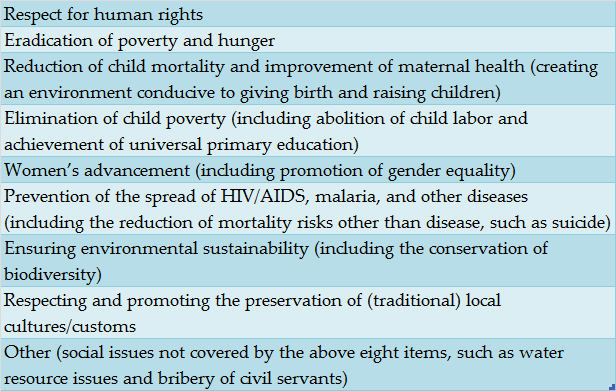
Some of the items in the global classifications are those that still require attention overseas but have largely been overcome within Japan, such as improving maternal healthcare and preventing epidemics. For these items we broadened the scope of our definition; in the case of maternal health, for example, instead of focusing narrowly on initiatives to reduce child mortality and the risk of death from disease during pregnancy, we included such related factors as the creation of a social environment conducive to bearing and raising children.
In our survey, we asked respondents to choose which social issues their CSR activities aimed to resolve based on our nine-item classification. They were asked to make separate responses for their domestic and overseas operations, giving a total of 18 items from which to choose. We also provided reference materials with specific examples to give respondents a clearer idea of the social issues in question.
We also asked them about the content of their CSR activities for each issue, the process from planning through implementation, the results achieved from their activities, and the activities that they regarded as being most successful. They were also asked to provide basic information about their company’s organizational setup and budget for CSR activities to facilitate our analysis.[4]
2. Questionnaire Results[5]
(1) Targeted Companies and Features of Respondents
We sent questionnaires to 2,082 companies, namely: (1) corporations listed in the first sections of the Tokyo, Osaka, or Nagoya stock exchange, (2) leading unlisted companies, (3) major foreign affiliates, and (4) companies that volunteered to participate.
We received valid responses from 218 companies. Of these, 185 (85% of the total) were from corporations listed in the first section of the Tokyo Stock Exchange; 12 (5%) from unlisted companies, 5 (2%) from foreign affiliates, 5 (2%) from companies that volunteered to participate, and 13 (6%) from companies listed in the Second or Mothers Section of the TSE or on other exchanges (Figure 2).
Figure 2. Responding Companies by Stock Exchange Listing Type
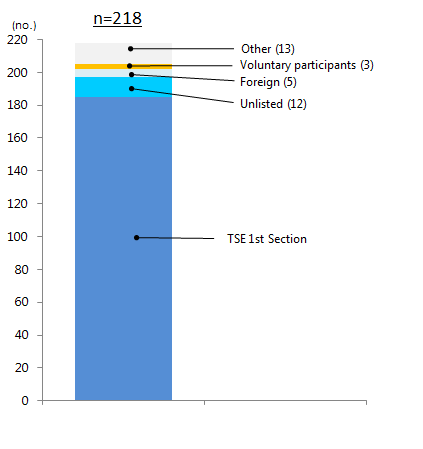
Broken down by industry, the largest number of responding companies was in the field of electric appliances: 23 companies, accounting for 11% of the total. Next was wholesale trade, with 19 responding companies (9% of the total), followed by chemicals, 17 (8%), banks, 16 (7%), foods, 14 (6%), and services, 12 (5%). The top five industries accounted for 41% of the responses. Figure 3 shows the overall breakdown.
Figure 3. Responding Companies by Industry
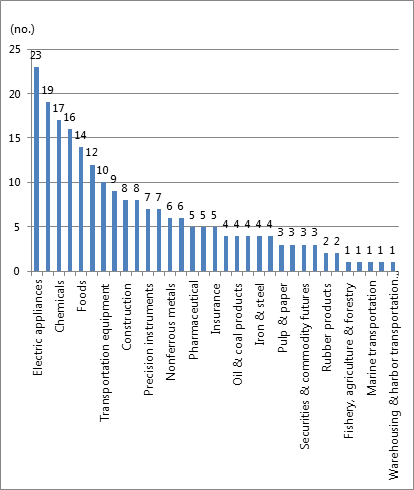
By age of the company (Figure 4), 51 of the responding enterprises were 60–69 years old—the biggest age group—followed by 70–79 (30 companies), and 90–99 (23). Together, these three cohorts accounted for about 50% of the total. So a large number of responding companies were established from around the second decade of the twentieth century through the early post–World War II period.
Figure 4. Corporate Age of Responding Companies[6]

(2) Initiatives by Type of Issue
Looking at the initiatives being undertaken by type of social issue, we found major differences among the nine categories and also between domestic and overseas measures. Below is a comparison of the domestic and international activities of the responding companies.
(i) Initiatives in Japan and Overseas
Figure 5 shows the numbers of companies implementing CSR activities within Japan for each social issue. The highest share of companies, at 96%, was engaged in environmental initiatives, such as efforts to counter pollution and climate change and to protect biodiversity. Other categories with high responses were cultural preservation (preserving local traditions and cultures), improvement of maternal health (including support during the prenatal and postnatal periods), human rights (of all forms), and women’s advancement (promoting women to management positions and creating comfortable working environments). Well over half of the responding companies were undertaking initiatives to address the issues in these areas.
Figure 5. Numbers of Companies Addressing Domestic Social Issues[7]
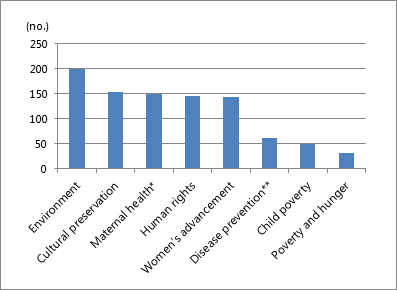
** Issues relating to disease prevention, in addition to the prevention of HIV and other diseases, also include the reduction of other mortality risks, such as suicide.
Relatively few of the responding companies reported activities in the area of disease prevention, such as measures to prevent illnesses, accidents, suicides, and other common causes of death for each age group, or in the areas of eliminating child poverty or eradicating poverty and hunger, in spite of the fact that the relative poverty rate has been on the rise in Japan. These areas may be in need of greater efforts to address social issues.
Figure 6 shows the numbers of companies implementing CSR activities overseas. Again, the environment is the category with the largest number of companies undertaking initiatives—67% of the total. The figures for all the other areas are less than 50%. After the environment, the areas most commonly addressed in descending order are human rights, elimination of child poverty, eradication of poverty and hunger, and cultural preservation; only about 30% of the responding companies reported involvement in these fields. The category with the lowest engagement was maternal health, in which only 23% (48 companies) reported that they were implementing activities. So there is an imbalance in the areas being addressed overseas, with relatively few companies tackling issues except the environment.
Figure 6. Numbers of Companies Addressing Overseas Social Issues[8]
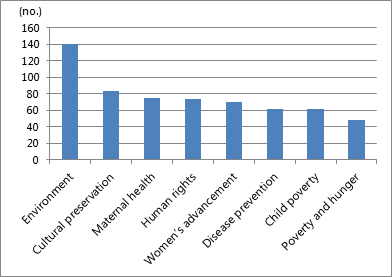
When we look at corporate CSR reports, we find that the examples they cite of initiatives taken overseas in many cases take the form of volunteer activities undertaken by their employees; there is little mention, for example, of attention being given to human rights in the local community. Though specific initiatives addressing social issues are being taken overseas, there are nonetheless many gaps when we look at the breakdown by issue.
(ii) Findings from a Domestic-Overseas Comparison
Many Japanese corporations have actively expanded their operations overseas in a quest for new markets and to optimize their supply chains. The maturation of the domestic market and the course of the exchange rate in recent years have accelerated such moves, and companies are expected to build close relationships with local societies overseas. Just as within Japan, they cannot ignore the important social issues in the locations where they are operating.
Are there differences in companies’ initiatives within Japan and overseas? Figure 7 shows the numbers of companies implementing CSR activities for the various categories of social issues, comparing the figures for within Japan and overseas. The first point we note is the difference in the total figures: The overseas total comes to 692, only two-thirds of the domestic total of 1,069. In the categories of cultural preservation, improvement of maternal health, and women’s advancement, the domestic figures are more than twice the figures for overseas. And the share of companies addressing social issues is above 50% in five of the eight categories domestically but only one of the eight overseas.
Figure 7. Numbers of Companies Addressing Social Issues: Domestic/Overseas Comparison
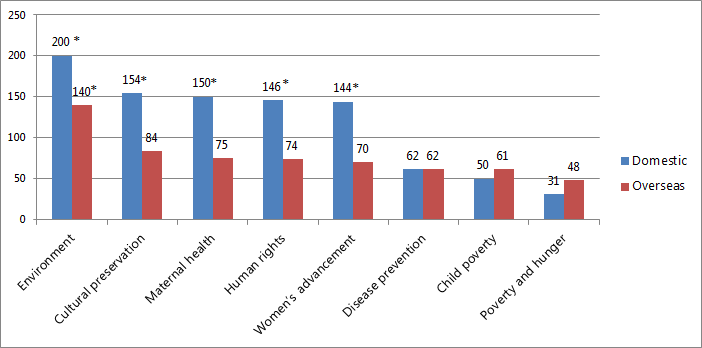
There are not many industries in which companies can confine their operations to within Japan, and while companies have been actively extending their overseas operations, their CSR activities still tend to focus on the resolution of domestic social issues. CSR is important for the creation and maintenance of corporate value, though, contributing both to long-term competitive strength and to risk management. So the expansion of these initiatives—along with the adoption of a corporate mind-set to make this possible—can be identified as an issue for the companies surveyed.
The environment was the field with the largest numbers of companies undertaking initiatives both within Japan and overseas. This may be taken as an indication of Japanese companies’ strength in this field; a comparison of the domestic and overseas figures shows, though, that there is still room for growth in companies’ overseas undertakings.
The results in the category of cultural preservation may be seen as reflecting concern for the communities in which companies’ operate, both within Japan and overseas. Especially with respect to overseas initiatives, though, scrutiny of the specific activities may be required to determine whether they are truly making a valuable contribution to the communities in question.
The contrast between the domestic and overseas figures in the category of maternal health may be only natural in view of the qualitative difference in the issues involved. But the domestic-overseas contrast in the categories of human rights and women’s advancement bears noting. The issues in these categories are basically the same in Japan and elsewhere; the existence of such wide gaps between domestic and overseas initiatives may be attributed to a lack of a global perspective on these issues at Japanese companies. One wonders if the Japanese word for human rights, jinken (人権), is actually synonymous with the terms used in other languages. There may be a need to reexamine the concepts of human rights and women’s advancement in a global context from the standpoint of protecting corporate value.
In the categories of child poverty and of poverty and hunger, the numbers of companies conducting initiatives overseas are substantially higher than the numbers within Japan; this reflects the differences of circumstances, particularly between Japan and developing countries. But the numbers of companies involved are comparatively low, and companies need to do more both within Japan and overseas, especially as these are fields with great importance for human life and survival.
Figure 8 presents the child poverty rates among members of the Organization for Economic Cooperation and Development listed in declining order; Japan is in ninth place with a relatively high rate. Figure 9 shows the changes in the Japanese rate in recent years. As this graph indicates, the overall trend is upward, albeit with some fluctuations. So this can be identified as a social issue that needs to be addressed.
Figure 8. Child Poverty Rates in OECD Member Countries[9]
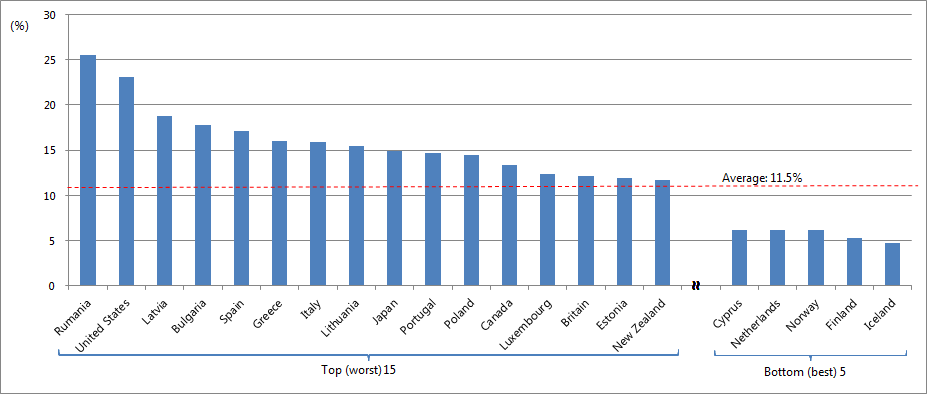
Figure 9. Japan’s Child Poverty Rate, 1985–2009[10]
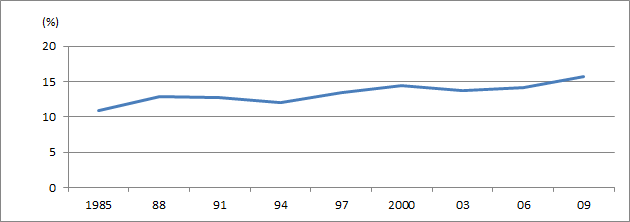
Two issues that are apparent from this look at CSR activities by category are (1) the need to expand efforts to resolve social issues overseas and (2) the need to strengthen initiatives in fields like poverty within Japan that require resolution but that are not adequately addressed by CSR activities.
(3) Approaches Used in CSR Activities
There are various approaches by which companies undertake to resolve social issues through CSR. These include using a portion of the profits from business activities, volunteering by managers and employees, and conducting a “base of the pyramid” business where the company’s products, services, human resources, and know-how are used for the resolution of social issues. In this section we will look at the approaches used in CSR activities broken down by social issue.
Figure 10 presents a breakdown of domestic activities for the resolution of social issues by issue and approach, and Figure 11 presents a similar breakdown of overseas activities. The approaches are classified as (1) implementation of the company’s own programs (including business activities), (2) volunteer participation by managers and employees in outside social activity programs, (3) donations of the company’s products or services, and (4) monetary donations.
Figure 10. Domestic Activities by Issue and Type of Approach[11]
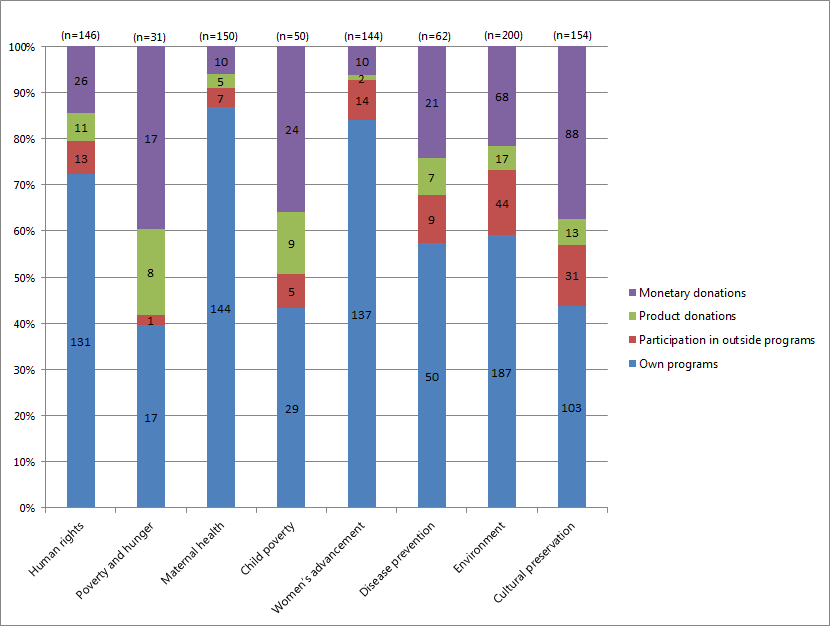
Figure 11. Overseas Activities by Issue and Type of Approach[12]
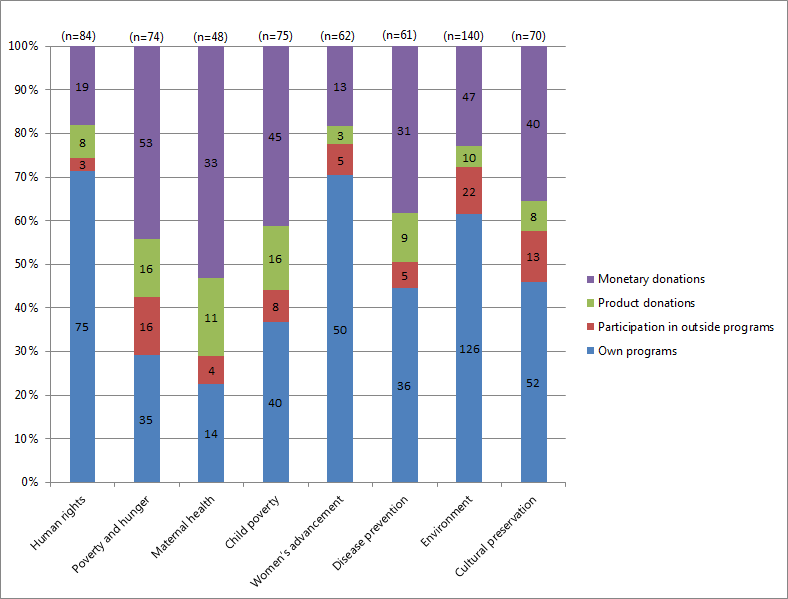
As the graphs indicate, for every issue the main approaches taken are implementation of the company’s own program (including business activities) and monetary donations; volunteer participation in outside social activity programs and donations of the company’s products or services are not common.
The contents of companies’ activities by issue can be grouped into three types: (1) “own program” type, where almost all of the activities are implemented in the form of the company’s own programs, (2) “monetary donation” type, where almost all of the activities are implemented in the form of monetary donations, and (3) “own program/monetary donation balance” type, where the two approaches are close to equilibrium (Table 1).
Table 1. Comparison of Approaches to CSR Activities
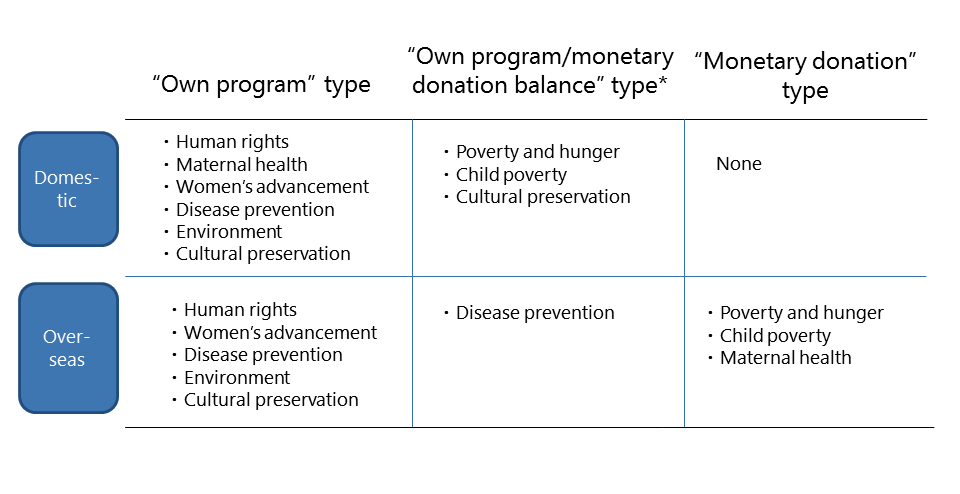
Overall, the “own program” type is most common for many categories. The “monetary donation” type is seen only in some overseas categories. This is probably because domestic social issues are relatively easy for companies to grasp and to find ways of resolving; this facilitates the implementation of initiatives in the form of companies’ own programs.
(4) Characteristics of CSR Activity Formulation and Related Issues
(i) Greater Emphasis on Action than on Deliberation
Rigorous implementation of the PDCA (plan-do-check-act) cycle in corporate activity processes has come to be of great significance in recent years, not only as a means of improving companies’ earnings but also as an approach to fulfilling responsibilities to stakeholders.[13] CSR activities are one form of corporate activity, and observing the state of their PDCA cycles offers one interesting perspective on them.
Table 2 presents a comparison, broken down by social issue, of the number of companies that have conducted deliberation (the “plan” step of the PDCA cycle) and that have taken concrete action (the “do” step). This shows that in every category, both within Japan and overseas, the emphasis in the surveyed companies’ CSR activities is on implementation. We can see from the survey results that this emphasis on taking action also applies to the areas that we identified in the previous section as gaps in terms of efforts to resolve social issues.
Table 2. Numbers of Companies That Have Deliberated Issues vs. Numbers That Have Acted on Them
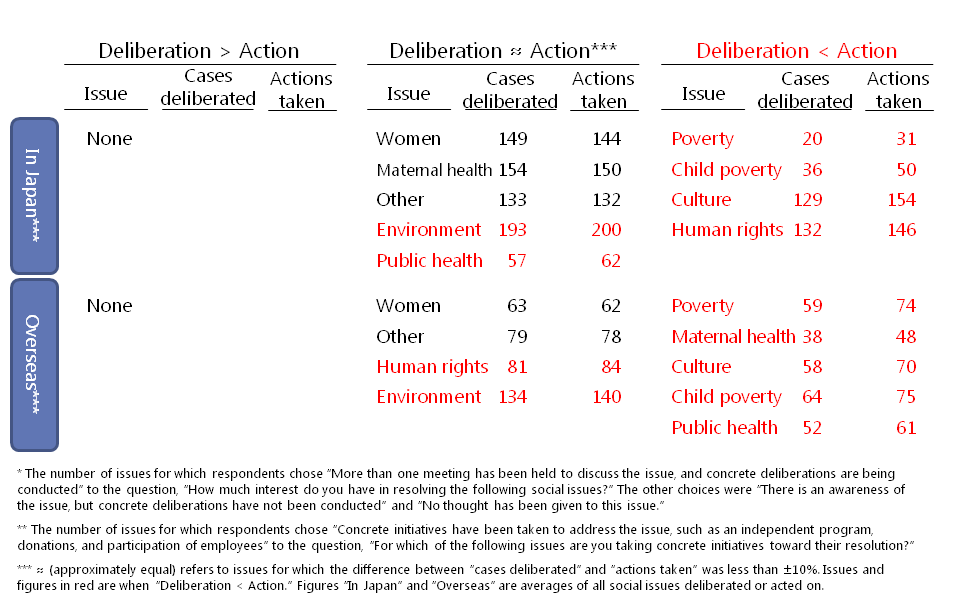
This result is also evident from companies’ CSR and integrated reports. Many Japanese companies disclose information about their CSR activities, but it tends to consist just of snapshots of officers and employees participating in volunteer activities and strings of explanations of the individual activities undertaken. We see little by way of overall explanations that tell how the company as a whole has chosen the social issues to address and how it is implementing its efforts based on their relevance to the company’s own business. So, as noted in another section of this report, the emphasis on implementation results in a state of affairs where companies are taking a “stapler” approach to CSR activities, binding together catalogs of their individual good deeds on an unsystematic basis.
(ii) Having a Department Dedicated to CSR Promotes Deliberation
How might the tendency to emphasize implementation over deliberation be corrected? We conducted a cross-tabulation analysis of factors promoting deliberation as part of the overall process, matching them against a number of variables. This revealed that companies with a department dedicated to CSR (including those that also handle other matters) have higher numbers of deliberation-based CSR activities and smaller numbers of activities not based on deliberation. Figure 12 presents the ratios of deliberation-based to nondeliberation-based activities for each category of social issue at companies with dedicated departments, and Figure 13 presents the corresponding data for companies without such departments.
Figure 12. Ratios of Deliberation-Based Activities to Non-Deliberation-Based Activities at Companies with Dedicated CSR Departments
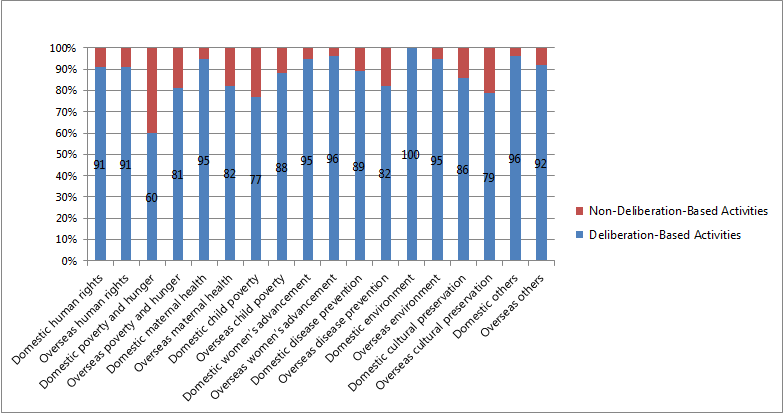
Figure 13. Ratios of Deliberation-Based Activities to Non-Deliberation-Based Activities at Companies without Dedicated CSR Departments
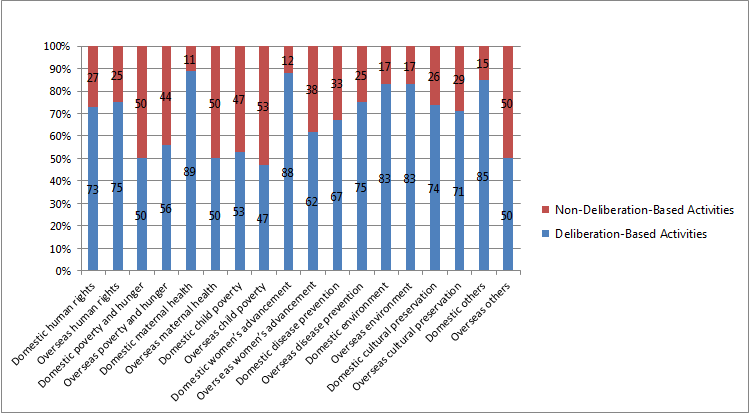
Comparing the two graphs, we see that the ratio of deliberation-based CSR activities at companies with dedicated departments is higher than at companies without such departments for every category of social issue. Also, at companies without such departments, there are six categories of social issues for with nondeliberation-based activities account for around half of the total, while at companies with such departments, there is not a single category for which this is the case. It seems reasonable to say that the existence of a dedicated department promotes the inclusion of deliberation as part of the process of CSR formulation. The details of the mechanism by which a dedicated department contributes are a matter for future study, but we can at least say that the establishment of a dedicated department is an effective means of alleviating the tendency to emphasize implementation over the deliberation process.
(5) The Ideal Approach and Actual Performance
(i) Introduction
How can CSR initiatives be integrated more fully into a company’s business operations? This has long been a major topic of concern both for corporate managers and CSR specialists and researchers. It is a difficult problem to which no effective solution has yet been found. In this section we will examine the relevance of CSR activities to business operations with this question in mind.
First we will look at companies’ ideal vision of the relationship between CSR and business operations and note how this is connected to the integration of the former with the latter. Next we will look at this relationship in all the categories of social issues covered by the survey, analyzing the results and considering the differences.
As part of our survey, we asked respondents to identify three of their CSR activities that they viewed as successful and that they wished to share with society. In other words, we asked for their “top three” activities. Looking at the results, we found many citations of activities relating to the environment, including climate change and biodiversity, and to assistance for recovery and reconstruction from disasters, particularly the Great East Japan Earthquake of March 2011. [14]
The questions in the survey included items concerning the content of the companies’ activities and the results of those activities and their relevance to their business operations. These questions revealed the state of CSR activities in terms of their relevance and results relative to companies’ ideals.
In what follows, we will first show the ideal vision of the relationship between CSR activities and business operations as revealed in the responses, and next we will look at the extent to which they are achieving the results that they consider ideal.
(ii) The Ideal: Integration with Business Operations
Figures 14 and 15 show the relevance of the activities that companies cited as their “top three” to their business operations.
Figures 14 & 15. Approaches to Implementation of “Top Three” CSR Activities and Approaches by Issue[15]

Looking at the results, we find high figures for two types of relevance: (1) implementation as an outgrowth of the company’s production, sales, hiring, or other business practices, such as efforts to reduce or purify the wastes and emissions resulting from their procurement and production processes, consideration for various types of human rights, and active moves to promote women to senior posts, and (2) use of the company’s own products or services, for example, through the development of medicine for the treatment of rare diseases and development of new products using Fukushima-grown crops stigmatized by their association with the nuclear accident. The figure is low for relevance through the use of profits from business operations, a category consisting largely of donation activity. So we can see that companies’ quest is to conduct activities that are in tandem with their business operations rather than ones that make use of the profits from their operations.
The ideal for CSR is to conduct it in ways that make use of products or services generated by the company’s business operations or that operate through the company’s business processes—in other words, CSR that is integrated with the company’s business operations.
(iii) The Reality vs. the Ideal
To what extent and in what areas are CSR activities actually integrated with business operations?
In our survey we investigated the relationships between CSR activities in each category and companies’ business operations. The details by category are presented in the next chapter analyzing the survey results; here we will consider some representative examples, highlighting the actual state of integration with business operations in the case of companies’ “top three” categories and their initiatives directed at specific social issues.
In the case of CSR activities that companies themselves rate as successful (their “top three”), there are high levels of usage of the company’s own products or services and activities implemented as part of the company’s business operations. But when we look at initiatives directed at specific social issues, out of the 18 domestic and overseas classifications, the only one that shows a similarly high level is that of domestic efforts in the field of the environment.
In the field of human rights, the level of implementation as part of the company’s business operations is as high as it is in the case of the “top three,” but the use of the company’s own products or services is low, so we cannot say that the activities in this field are truly integrated with business operations. This applies both within Japan and overseas, and it is also true in fields like women’s advancement.[16]
In the field of child poverty, the number of initiatives is very small, and their only
relevance to the company’s business is that they utilize business profits and are implemented in the course of normal business operations, so the state of affairs is far from ideal in terms of integration. A similar tendency is widely seen in initiatives addressing social issues overseas, where, as in the case of child poverty, there is a general lack of awareness of the issues and of action based on such awareness in many fields.
So domestic initiatives in the field of the environment are the only ones for which integration with business activities has been achieved.
Next let us look at relevance to business operations broken down by category. Figures 16 and 17 show the breakdown for initiatives within Japan and overseas, respectively.[17]
Figure 16. Relevance of CSR Activities to Business Operations by Issue Category (Domestic)[18]
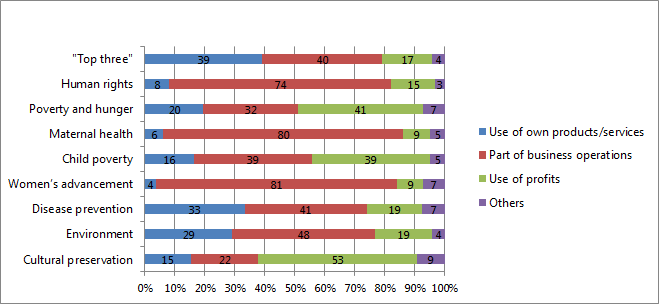
Figure 17. Relevance of CSR Activities to Business Operations by Issue Category (Overseas)[19]
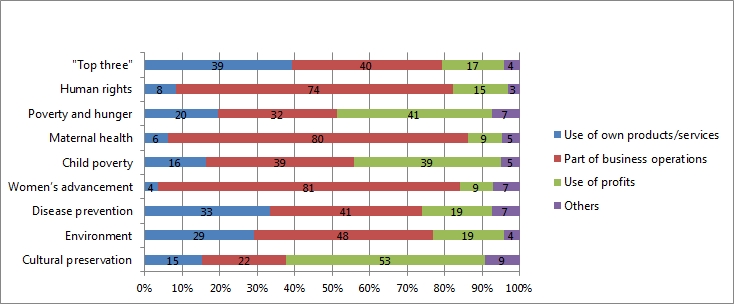
Looking at the domestic figures, we find five categories of social issue in which implementation as part of the company’s business operations has a share above 50% and three in which the share is between 40%–50%. So this form of relevance is the most prevalent. Next comes the use of profits, with shares above 50% in four categories and in the 40%–50% range in two. The lowest shares are for the use of the company’s own products or services, in which not a single category has a share above 40%.
So companies’ actual activities—while showing some variation when broken down by type of social issue—have progressed to a certain extent in achieving relevance to business operations for domestic social issues, but they have yet to achieve such relevance in the use of the company’s own products or services. In their overseas initiatives, companies are mainly just using their profits; they are far from achieving relevance. As the next set of steps, companies will need to (1) strengthen the links between CSR and their own products and services within Japan and (2) more fully incorporate CSR into their business operations overseas. The case studies presented elsewhere in this report can serve as hints for how to take these steps.
(6) Results Achieved from CSR Activities by Issue
(i) Introduction
How CSR activities are assessed and how they contribute to corporate value are difficult to grasp even for those actually involved in their implementation, and specialized research does not offer clear clues either. In the CSR reports that companies publish, corporate value and social value are measured as fundamentally separate items, and quantitative measures covering both types of value are rarely offered. Companies commonly present evaluations based on key performance indicators (KPIs) that measure social value.[20] But as noted repeatedly in this report, corporate value and social value are not conflicting objectives; corporate activities aimed at integrating the two and enhancing them together can, at the same time, promote sustained social development and achieve a competitive edge for the company over the long term.
In this section, with this in mind, we will look at the results of CSR activities from the perspective of corporate value. To be sure, it is not realistic to expect companies to immediately start providing quantitative readings of this sort. As a starting point, we will examine what companies regard as the ideal relationship between their CSR activities and corporate value. Next, as in the previous section, we will look at the results by individual issue and compare these results with the ideal.
(ii) The Ideal: Direct Contribution to Corporate Value
Figure 18 presents the contributions to corporate value made by companies’ “top three” CSR activities. An improved corporate image was the most commonly cited contribution, but over 50% also cited human resources development (through the improvement of childcare leave systems and the active appointment of women to managerial posts), new business opportunities, and enhancement of the company’s technological strength. And close to half reported higher earnings.
Figures 18 & 19. Results from Companies’ “Top Three” Activities and Results by Issue[21]

Companies position CSR activities as ideally contributing to the enhancement of corporate value. If we combine this with the findings from the previous section, we see that what companies seek in their CSR activities is integration with their business operations in terms of both relevance and benefits.
(iii) The Environment: Ideal Results in Japan and Overseas
What results have companies actually achieved through their CSR activities? As in the previous section, where we looked at the relevance of the activities to companies’ business operations,[22] here again we will start by presenting some representative examples and highlight the relationship between the ideal vision of CSR activities and the benefits achieved from specific initiatives.
In the case of CSR activities that companies themselves rate as successful (their “top three”), the results have led to enhancing corporate value. But when we look at initiatives directed at specific issues, out of the 18 domestic and overseas categories, the only one that shows a similar pattern is domestic efforts in the field of the environment—just as in the case of relevance to business operations, though the results are not quite so positive.
For activities in the field of human rights, results are limited to human resources development and recruitment, while for those in the field of child poverty, improvement of the company’s image is the only prominent result.
The trends observed in terms of results are similar to those seen in the case of relevance to business operations. Figures 20 and 21 show the breakdown of results by social issue for initiatives within Japan and overseas, respectively.[23]
Figure 20. Types of Results Produced by CSR Activities (Domestic Social Issues)
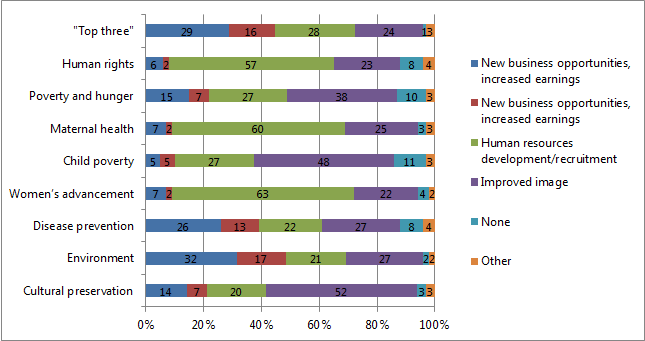
Figure 21. Types of Results Produced by CSR Activities (Overseas Social Issues)
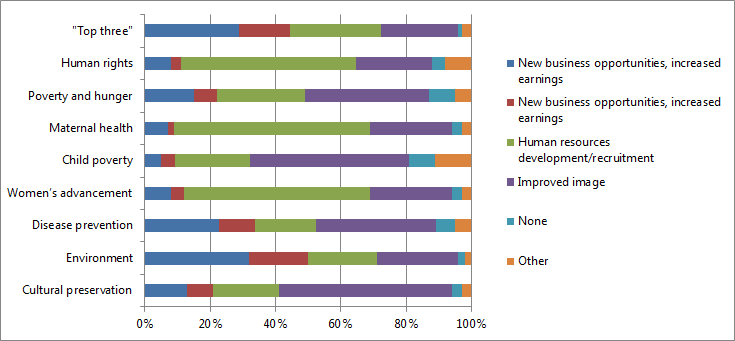
The survey findings reveal no major differences between the results achieved from CSR activities in Japan and those overseas in terms of the effect on corporate value. The differences are more pronounced between categories of social issue. The results from companies’ “top three” include large shares of short-term, direct effects, such as expansion of operations and earnings and enhancement of technological strength, but the overall results by social issue show low shares of activities producing such direct effects.
Direct effects on corporate value like the ones observed for the “top three” activities are seen only in the case of environment-related initiatives in Japan and overseas. Disease prevention comes next, with a relatively high share. The companies undertaking initiatives in this field are limited to particular industries, and the relevance of such initiatives to their business operations is relatively high, but even so, improvement of corporate image accounts for a large share of the responses. In other categories, the main results reported are in human resources development and recruitment and in image improvement. Expansion of operations and earnings and enhancement of technological strength—results directly impacting corporate value—account for less than 10% of the responses.
So the results of CSR activities are approaching the ideal—enhancing their corporate value directly as well as contributing to it indirectly over the medium-to-long term—only in a few fields, such as the environment and disease prevention. The actual results achieved consist mostly of longer-term, indirect effects, such as image improvement and human resources development and recruitment. A key issue for CSR going forward will be finding ways to achieve results that will contribute directly to corporate value from activities undertaken across the spectrum of issues.
Our survey did not reveal the drivers for achieving results like business expansion or higher profits from CSR activities, but cross-tabulation analysis shows that companies that are conducting dialogue with socially vulnerable groups and nonprofit organizations and those that are working in tandem with outsiders, including NPOs and specialists, are achieving such results more successfully than those that are not. Though it may seem like a roundabout approach, undertaking repeated, attentive dialogue in connection with specific activities, finding social issues appropriate for the company to address, and understanding the wellsprings of the company’s own competitive strength are what make it possible for a company to embark on cooperation with others. And it is probably fair to say that companies that have the human resources capable of this sort of attentiveness are the ones that can achieve the integration of their CSR activities with their business operations and produce successful results in terms of both social and corporate value.
(7) Areas for Improvement in CSR Activities
Various studies have already revealed a number of areas for improvement in the conduct of CSR, such as extension throughout the company, incorporation into business operations, and formulation of indicators for evaluation. These studies have largely evaluated CSR and identified issues on the basis of existing guidelines like ISO 26000 or have focused on the issues recognized by companies’ CSR implementation departments.
Properly speaking, however, CSR activities should not be something handled just by the implementation department but rather be conducted through integrated efforts encompassing management and various operating departments. It is also important to survey the views of those outside the implementation department on problem areas relating to CSR.[24] Our survey thus sought the views of three different areas of each responding company: the executive level, in the operating departments, and in the CSR implementation department.[25]
(i) Differences Depending on the Organizational Locus
We asked survey respondents in each of the three divisions to identify the issues their company faced in promoting CSR. The answers were in written (as opposed to multiple-choice) form, and we used text mining and qualitative analysis to classify and tabulate the results.[26] Table 3 presents the top five types of issues we found in each of the three divisions.
Table 3. Top Issues for CSR Activities as Viewed from Different Loci in the Company

Differences of main issue types were seen depending on the locus. At the executive level and in the operating departments, the most frequently cited set of issues concerned ways of linking CSR activities with business operations and fitting the former into the latter, while in the implementation departments the top set concerned spreading policy awareness throughout the company. In other words people in the implementation departments sense that the basic ideals and guiding principles are not shared by others in their company, an issue more fundamental than that of integrating CSR activities with business operations. We can interpret what we see here as being two sides the same coin: People are viewing the same issues from different standpoints. But while those in the CSR implementation departments are focusing on ideals and modes of thinking, feeling concern over the lack of progress in incorporating CSR policy into the company’s business operations, those at the executive level and in the operating departments are more interested in concrete action. This may reflect the emphasis on implementation over deliberation that we touched on earlier. And given the fact that CSR is a term with a variety of definitions, we can imagine the depth of the concern felt by members of the implementation departments. The insufficient understanding of CSR that is one of the top types of issues at the executive level and in the operating departments may be seen as another manifestation of this same situation.
Meanwhile, many implementation and operating departments cite insufficient resources, but executives seem to be relatively unaware of this issue. This suggests that the departments actually planning and carrying out CSR activities encounter shortages of resources, including personnel and funds, but this information is not reaching the executive level.[27]
In contrast, little difference was seen among the three loci in their awareness of how to adjust CSR activities so as to cope with the globalization of markets. This seems to indicate a shared recognition of this issue across organizational lines. It may also be taken as evidence of progress in sharing the idea of promoting CSR to preserve corporate value as one aspect of risk management.
So we see that even within the same company, the view of CSR activities is not uniform but varies from one locus to another. And even within organizational units information is not adequately shared. An important key to the development of CSR activities henceforth will be to find was of narrowing such internal gaps and establishing a companywide PDCA cycle for CSR.[28]
3. Where Is CSR Headed and What Should It Do?
(1) The Importance of Selection
We can see the current state of CSR activities in Japan by observing the contrast in the levels of attention being paid to various social issues. Almost all of the responding companies are involved in environment-related activities, including measures to address climate change and to preserve biodiversity. But only about 70% of them are addressing issues in the areas of human rights and women’s advancement, which ought to be core concerns for corporate management. And fewer than 30% are involved in seeking to resolve the issues of disease prevention and mortality reduction and of poverty and hunger, which are universal concerns and are also becoming more serious within Japan.
Social issues are diverse, and so are companies. So why do we see this sort of sharp contrast between widely addressed and little addressed issues? One factor that may be cited is the strength of companies’ herd mentality. If we look at the changes in the shape of CSR, we find trends that reflect the times, and many people involved in CSR report that their companies’ activities have been conducted with an eye on what other companies are doing.
But we think the essential cause lies at a deeper level. As noted above, Japan’s CSR is characterized by an emphasis on implementation, with relatively little weight placed on deliberation (see Figure 22). When we conducted the survey, many of the target companies commented that while they were accustomed to describing their CSR activities, they had never been asked what social issues they were trying to resolve. They were able to speak eloquently about what they are doing, but they give little attention to the purpose of those activities.
Figure 22. Three Approaches to Integrating Business Operations and Resolution of Social Issues[29]
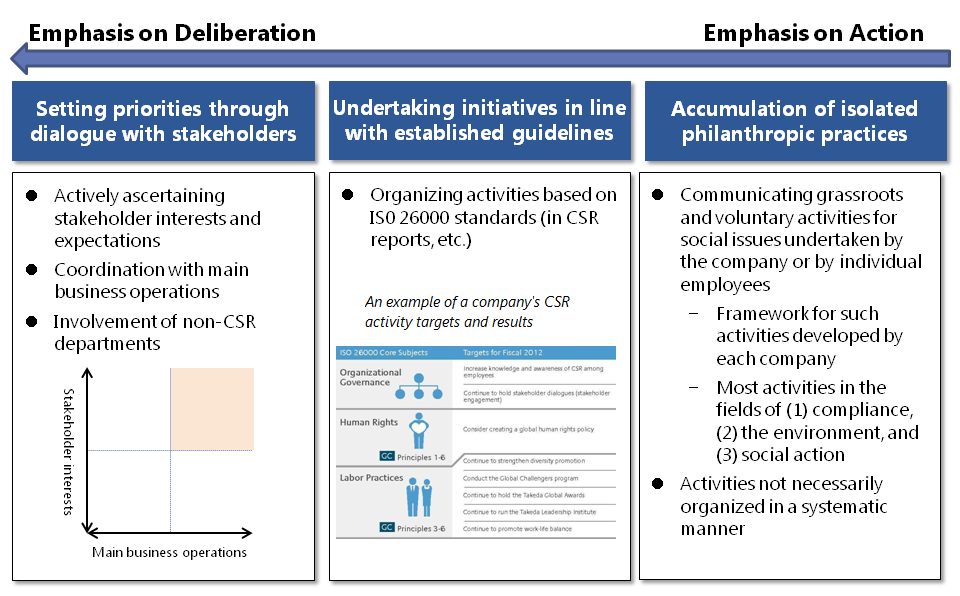
As we noted in the Overview section of this report, Japanese companies are wont to take a “stapler” approach to CSR, merely binding together sheaves of documents cataloging the good deeds they have done. Without a process of deliberation to determine what sorts of social issues exist, what society expects of the company, what are the fields in which the company can tap its strengths, and what social issues the company will seek to resolve, the content of CSR programs is likely to end up being shaped by what other companies are doing or by the inclinations of a few top executives.
Needless to say, in order for a company to achieve the ideal integration of efforts to resolve social issues with business operations, it needs to repeatedly conduct dialogue with stakeholders and make use of guidelines based on a good grasp of their significance. We would also note that integration of CSR with business operations is crucial for the sake of creating and maintaining corporate value. Above all, these initiatives should be grounded in an awareness of the relationship between society and the company. The key challenge is to position CSR in such a manner as to solidify the company’s raison d’être.
CSR stands for “corporate social responsibility,” which is commonly translated as kigyō no shakaiteki sekinin (企業の社会的責任) in Japanese. Sekinin, the word used for “responsibility,” also denotes “obligation,” and so perhaps the use of this term has caused companies to feel that they need to follow the example of others. But if we consider the original English term carefully, we see that it is derived from “respond.” And native speakers of English tell us that this word refers not so much to the stiff, lifeless reaction to an external stimulus—like a balloon buffeted by the wind—as to a flexible, animated response. This is the sort of response that is demanded of companies by their stakeholders throughout society. The nature of the demands will vary from company to company, and so of course will the methods by which they respond. But it is by responding dynamically that companies display their raison d’être within society. “Corporate social responsibility” may be taken to refer precisely to this raison d’être.
What are the most compelling social issues currently confronting Japan? What are the social issues that companies can address, putting their corporate raison d’être on the line and tapping their strengths to respond to all their stakeholders in society? Companies need to think carefully about these questions by conducting a thorough process of deliberation.
And what about issues outside of Japan? Japanese companies are doing little to address social issues overseas except in the field of the environment. And even in that field, their efforts fall short of what they are undertaking domestically. If we look at their initiatives as a whole, comparing those in Japan to those overseas, we see a clear emphasis on the domestic side.
In terms of tapping strengths, if, as is often noted, Japanese companies’ forte is in the environment, then they can probably expand their initiatives more actively in this field. And by applying the technologies developed in Japan at overseas locations, they may be able to transform the CSR activities that they have implemented as part of their business processes into direct sources of corporate value. With respect to environmental affairs, some people note the lack of consistency in legal standards in Japan and elsewhere, but instead of waiting for the emergence of uniform standards, companies can make management decisions to redefine their strengths and actively apply them. In any case, it is important for companies to select social issues to address overseas, just as within Japan, in the light of their own corporate raison d’être.
(2) Initiatives as Part of Business Practices or in the Form of Donations
As shown in our analysis above, boosting the integration of issue-resolution initiatives with business operations leads to increased corporate value and is the ideal that companies are pursuing. In practice, however, it is only in the field of the environment that they have approached this ideal; overall its realization is still far off.
Japanese companies’ CSR activities mostly fall into two broad categories: (1) business practices that address problems like discrimination based on gender or disabilities and emissions of pollutants by making sure that the company’s business operations do not give rise to such problems or exacerbate their seriousness, and (2) donations making use of the profits arising from business operations, contributing to the resolution of social problems not as a direct actor but indirectly, by supplying money (or goods) to third parties like NGOs and others in the civil sector.
Activities in the first category are largely preventive, aimed at keeping the company’s own business operations from generating new social problems or exacerbating existing ones. Examples include ensuring compliance with laws and other provisions adopted for the sake of human rights and women’s advancement (such as bans on discrimination in hiring and on violations of privacy in business operations) and moves to improve childbirth and childcare leave systems, which are by far the most commonly seen concrete initiatives to address the issue of creating an environment conducive to childbirth and childcare.
Activities in the second category largely involve donating funds for the resolution of social issues outside the company, without becoming directly involved themselves. The survey revealed many examples aimed at resolving the issues of poverty and hunger and of maternal health overseas through donations to NPOs and NGOs; domestically, donations were made for festivals and other local events held in communities where the company operates—a common type of initiative in the field of cultural preservation.
Are these activities likely to continue? Given the changes in contemporary society and the circumstances in which companies find themselves in—particularly the inexorable progress of globalization—companies may be forced to change the nature of such CSR programs.
(3) Changes Due to Globalization
Starting in the latter part of the 1990s, the trend in the flow of goods around the world shifted.[30] Companies strengthened their supply chain management, setting up operations in locations across the globe for everything from procurement of raw materials through production, warehousing, and sales. If one includes intermediate goods, complex supply chains now extend across national borders. Some such chains start with raw materials, while others originate with markets close to consumers. The construction of supply chains optimally suited to the characteristics of companies’ materials, products, and customers has become essential for the sake of achieving a competitive edge. Many Japanese companies, unable to achieve sustained growth from operations in the mature, domestic market, have been moving into overseas markets with good prospects for further expansion. While some such moves have been more successful than others, the fact is that the number of companies stepping up cross-border activities to develop new markets and rebuild their supply chains has been on the rise. Globalization has hence become a precondition for successful corporate management.
How is the progress of globalization related to CSR?
Globalization has caused the scope of companies’ activities to broaden. Through their supply chains, the reach of their activities is continuing to grow, extending even to regions where they are not directly engaged in buying or selling. But in addition to fostering the spread of superior technologies and products and rare resources, globalization has also resulted in the cross-border transmission of pests, diseases, and technologies that can be used to make weapons of mass destruction, resulting in the creation or enlarging of social issues. Globalized companies are directly involved in moving resources across borders, and they are the prime beneficiaries of this movement. They are also the main actors in a position to take effective measures against the negative consequences. Increasingly, they are being asked to take steps to restrain the emergence of such issues.
Another way in which globalization relates to CSR is the need to deal with issues that arise through the cross-border contact of different cultures and value systems. Today’s multinational corporations need to build close relationships with many different regions with diverse cultures and values. They must understand and respect the cultures and values in those regions that differ from their own. This is easier said than done, though, and not a few companies have unknowingly walked into a hornet’s nest in the course of globalization. As noted elsewhere in this report,[31] the NTT Group’s international survey of readers of CSR reports has revealed the low level of awareness regarding human rights within Japanese society. This is a fact that needs to be more fully recognized.
Recognizing and addressing the social issues that accompany globalization contributes to the preservation of corporate value. The focus should be on foreseeing and taking action to prevent such issues from emerging, but this requires paying close attention to the various factors that are changing the shape of these issues, including globalization and advances in science and technology. Companies must keep an eye on shifting developments, both close-up and from a broader perspective. Maintaining such multiple viewpoints entails developing personnel who understand the languages both of social issues and business operations, but this is not something that can be accomplished overnight. Ongoing efforts are needed to promote dialogue with outside experts, conducted attentively and with open minds, and to position the CSR department as a division to develop human resources capable of viewing society from a long-term perspective. Companies must constantly strive to enhance their organizational ability to ascertain key social issues and to make judgments about how such issues are addressed.
As was made clear at the Rio+20 conference,[32] the capability of governments to resolve social issues has declined in relative terms, and companies should have an understanding of this fact. Government authority does not extend across national borders. Cross-border action requires agreements among governments, but such agreements are not easy to achieve today. Companies, by contrast, are operating across borders on a daily basis. They are in the best position to address cross-border issues. It may thus be only natural for society to expect global corporations to take the lead in tackling global social issues.
(4) The Future of CSR: Which Way Forward?
Economists often classify the constituent elements of society into (1) citizens, (2) the government, and (3) corporations (markets). They are the only ones who can resolve social issues. We have already pointed out the limits of governments; their capabilities are greatly constrained by national borders and by fiscal circumstances. As a result of the development of the welfare state, many industrially advanced nations face fiscal crises to one degree or another. To the extent that the problems in public finance result from excessive expectations directed at governments, the situation is clearly unsustainable.
Citizens and civic groups are also the target of expectations as potential actors, but in Japan, compared with other countries, their capabilities have yet to mature in terms of both scale and consciousness of their own role.
For companies, meanwhile, the resolution of social issues acts as a source of corporate raison d’être and contributes to the creation and maintenance of corporate value. Companies have technological and organizational power and are good at adopting and expanding the scale of innovations. So they are the best positioned to broadly spread the benefits of social issue resolution.
The relationships between citizens, the government, and companies have changed over time. We are entering an age in which companies will need to stand at the forefront of initiatives for resolution of social issues.
Our survey revealed that Japanese companies have the desire and the will to integrate their CSR activities with their business operations. They have gained a deeper awareness of the imperatives accompanying society’s demands and the various social changes, and they have a good idea of what they want to achieve. In practice, however, they have yet to reach their ideal and continue to implement earlier initiatives. This is where Japan’s CSR stands. Said another way, companies have a clear view of what they need to do but are struggling to break out of their current box and move on to the next stage.
Our project has involved a quantitative analysis based on a questionnaire survey, along with case studies and qualitative analysis based on direct interviews. Our aim has been to allow both society and companies to reconfirm and share their vision of the desired shape for CSR and to contribute at least something to the search for materials that will help achieve this. With this in mind, we will continue this survey in future years, enhancing its accuracy as an information infrastructure amenable to fixed-point observation. In fiscal 2015 (starting April 2015) we plan to carry on with a more detailed investigation into points like companies’ implementation of the PDCA cycle and their responses to globalization.
There is no need to go back to the idea that the resolution of social issues and the business operations of companies are totally separate and that they conflict with each other. The ideal is integration of CSR activities with business operations; people throughout each company—not just those in the CSR departments but also executives and those in operating departments—should be mindful of their respective roles in this pursuit.
[1] For example, Toyo Keizai publishes CSR kigyo soran (Comprehensive Corporate Listing of CSR).
[2] The NTT Group has been conducting this survey since 2000. It has also organized a symposium based on the survey results. See http://eco.goo.ne.jp/business/event/env_report/web_sympo2013/report01/01.html (in Japanese).
[3] One example is the survey by the Japan Sustainable Investment Forum (website in English at http://www.jsif.jp.net/#!english/c1tc5).
[4] We found that the measurement criteria for CSR budgets differ from company to company, making it difficult to aggregate the data using a uniform standard. How to advance the disclosure of nonfinancial information, including but not limited to that about CSR, may be a common challenge for many Japanese companies.
[5] Except where noted otherwise, the graphs and tables presented herein were created by the Tokyo Foundation on the basis of the CSR survey.
[6] Corporate ages are as of 2012. Compiled by the Tokyo Foundation from Kaisha Shikiho (Japan Company Handbook, Toyo Keizai, Inc.) and other sources.
[7] The results are a compilation of the replies to the question, “In which of the areas listed below has your company been taking concrete action for resolution of social issues?” with respect to domestic social issues.
[8] The results are a compilation of the replies to the question, “In which of the areas listed below has your company been taking concrete action for resolution of social issues?” with respect to overseas social issues.
[9] Compiled by the Tokyo Foundation from the OECD Family Database and data from Japan’s Ministry of Health, Labor, and Welfare.
[10] Compiled by the Tokyo Foundation from the OECD Family Database and data from Japan’s Ministry of Health, Labor, and Welfare.
[11] The results are a compilation of the replies to the question, “What specific sorts of activities is your company taking with regard to the areas [of social issues that you are addressing]?” (multiple response).
[12] The results are a compilation of the replies to the question, “What specific sorts of activities is your company taking with regard to the areas [of social issues that you are addressing]?” (multiple response).
[13] This is a good example of how the optimization of companies’ business processes has nowadays become legally mandated.
[14] The specific contents of the activities are presented in the following chapter analyzing the survey results. See the references to the six cited companies’ support for recovery and reconstruction from the Great East Japan Earthquake.
[15] The results are a compilation of the replies to the question, “How are your company’s CSR activities relevant to your business operations?” (multiple response). The “top three” are companies’ choices of the top three of the activities they have conducted that have produced successful results. The figures for activities addressing particular social issues are all domestic.
[16] Please refer to the issue-by-issue outline of CSR activities in section 6 of the next chapter outlining relevance to business operations.
[17] To facilitate comparison between the figures for the “top three” and other issues, these graphs present ratios using the total numbers of initiatives for each type of approach as the denominators. Please note that the values are different from the ones in Figure 14.
[18] The numbers within the graph are numbers of activities conducted. The results are a compilation of the replies to the question, “How are your company’s CSR activities relevant to your business operations?” (multiple response).
[19] The numbers within the graph are numbers of activities conducted. The results are a compilation of the replies to the question, “How are your company’s CSR activities relevant to your business operations?” (multiple response).
[20] Key performance indicators are quantitative yardsticks that measure the degree to which goals have been accomplished. They are used mainly to quantify results that are hard to measure numerically, such as levels of contribution to society and stakeholder satisfaction.
[21] The results are a compilation of the replies to the question, “Did the above initiatives enhance your company’s unique strengths?” (multiple response). The “top three” are companies’ choices of the top three of the activities they have conducted that have produced successful results.
[22] Please refer to the issue-by-issue analysis of CSR activities in the section describing the results achieved in the following chapter.
[23] The results are a compilation of the replies to the question, “Did the above initiatives enhance your company’s unique strengths?” (multiple response). To facilitate comparison between the figures for the “top three” and other issues, in these graphs we present ratios using the total numbers of initiatives for each type of approach as the denominators. Please note that the values are different from the ones in Figure 18.
[24] The interviews conducted by the Tokyo Foundation revealed the strong possibility of awareness gaps and conflicts of perspective between those working in CSR implementation departments and those at the executive level or in other departments.
[25] We should point out, however, that the actual respondents to our questionnaire were generally in companies’ CSR implementation departments.
[26] Our analysis yielded the following 11 classifications: (1) insufficient understanding of CSR (including lack of policy clarity), (2) lack of clear priorities, (3) [difficulty in] fitting into business activities, (4) coping with globalization, (5) spreading policy awareness throughout the company, (6) publicity to stakeholders and others outside the company, (7) collaboration with other departments, (8) difficulty in measuring effectiveness, (9) arrangements to keep activities going, (10) insufficient resources, (11) other.
[27] The written answers often mentioned both the lack of personnel and the lack of understanding at the executive level.
[28] Many case studies presented in this report were chosen with this point in mind.
[29] Compiled by the Tokyo Foundation based on corporate CSR reports and websites and Japanese National Committee for ISO/SR publications.
[30] From this period through the early 2000s, the flow of goods expanded dramatically, especially across the Pacific.
[31] In the overview article <http://www.tokyofoundation.org/en/articles/2014/overview-of-csr-in-japan>, in the case studies, and elsewhere.
[32] The United Nations Conference on Sustainable Development, held in Rio de Janeiro, Brazil, in June 2012.
